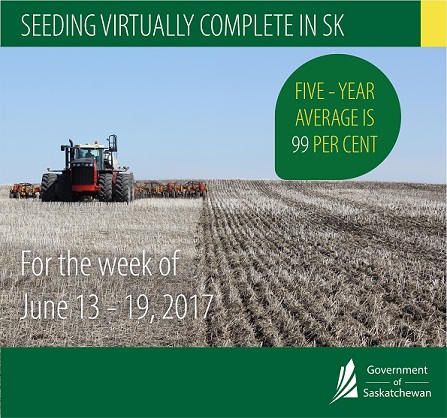Released on June 22, 2017
With the recent rainfall across the province in the past week, crop development has improved. The warm and wet weather was welcomed in areas that were experiencing moisture stress.Eighty-eight per cent of fall cereals, 60 per cent of spring cereals, 56 per cent of oilseeds and 70 per cent of pulse crops are at or ahead of their normal stages of development for this time of year, according to Saskatchewan Agriculture’s Weekly Crop Report.
Most of the province received rain in the past week, ranging from trace amounts to 112 mm, with a provincial average of 26 mm. Across the province, cropland topsoil moisture is rated as 10 per cent surplus, 68 per cent adequate, 18 per cent short and four per cent very short. Hay land and pasture topsoil moisture is rated as eight per cent surplus, 60 per cent adequate, 24 per cent short and eight per cent very short.
Topsoil moisture is lowest in the area south of Assiniboia (Crop District 3ASW), where 90 per cent of the cropland, hay land and pasture are short to very short of moisture, followed by the area around Shaunavon (crop districts 3BS and 4A), where 60 per cent of cropland and 84 and 80 per cent of hay land and pasture, respectively, are short to very short of moisture. The wettest crop districts are in the northwest (crop districts 9AE and 9B), where 45 and 46 per cent, respectively, of cropland and 40 and 35 per cent, respectively, of hay land and pasture have surplus topsoil moisture.

Persistently strong winds have damaged crops and delayed in-crop weed control in many areas. Cutworms, flea beetles, localized flooding, and lack of moisture continue to damage crops.
Producers are busy controlling weeds when they can and preparing for haying. Cattle have been moved to pasture.
SaskPower has received 156 reports this year of farm equipment coming in contact with power lines, with 22 incidents being reported so far in June. SaskPower urges anyone who has come in contact with electricity to seek medical attention immediately, even if there are no signs of injury.
A complete, version of the Crop Report is available at http://www.publications.gov.sk.ca/redirect.cfm?p=85975&i=99587.
Follow the 2017 Crop Report on Twitter at @SKAgriculture.
-30-
For more information, contact:
Brent Flaten
Agriculture
Moose Jaw
Phone: 306-694-3714
Email: brent.flaten@gov.sk.ca
